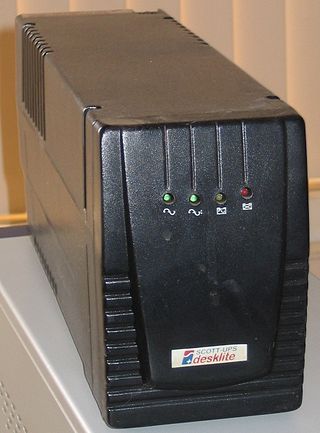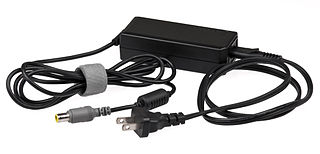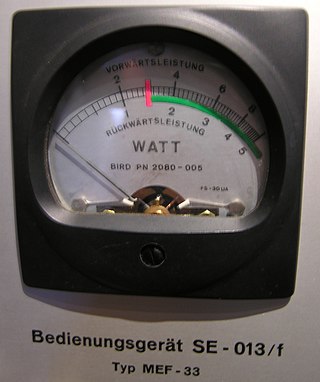In electrical engineering, the power factor of an AC power system is defined as the ratio of the real power absorbed by the load to the apparent power flowing in the circuit. Real power is the average of the instantaneous product of voltage and current and represents the capacity of the electricity for performing work. Apparent power is the product of root mean square (RMS) current and voltage. Due to energy stored in the load and returned to the source, or due to a non-linear load that distorts the wave shape of the current drawn from the source, the apparent power may be greater than the real power, so more current flows in the circuit than would be required to transfer real power alone. A power factor magnitude of less than one indicates the voltage and current are not in phase, reducing the average product of the two. A negative power factor occurs when the device generates real power, which then flows back towards the source.

An uninterruptible power supply (UPS) or uninterruptible power source is a type of continual power system that provides automated backup electric power to a load when the input power source or mains power fails. A UPS differs from a traditional auxiliary/emergency power system or standby generator in that it will provide near-instantaneous protection from input power interruptions by switching to energy stored in battery packs, supercapacitors or flywheels. The on-battery run-times of most UPSs are relatively short but sufficient to "buy time" for initiating a standby power source or properly shutting down the protected equipment. Almost all UPSs also contain integrated surge protection to shield the output appliances from voltage spikes.

A kilowatt-hour is a non-SI unit of energy equal to 3.6 megajoules (MJ) in SI units which is the energy delivered by one kilowatt of power for one hour. Kilowatt-hours are a common billing unit for electrical energy supplied by electric utilities. Metric prefixes are used for multiples and submultiples of the basic unit, the watt-hour.

A power supply is an electrical device that supplies electric power to an electrical load. The main purpose of a power supply is to convert electric current from a source to the correct voltage, current, and frequency to power the load. As a result, power supplies are sometimes referred to as electric power converters. Some power supplies are separate standalone pieces of equipment, while others are built into the load appliances that they power. Examples of the latter include power supplies found in desktop computers and consumer electronics devices. Other functions that power supplies may perform include limiting the current drawn by the load to safe levels, shutting off the current in the event of an electrical fault, power conditioning to prevent electronic noise or voltage surges on the input from reaching the load, power-factor correction, and storing energy so it can continue to power the load in the event of a temporary interruption in the source power.

A power strip is a block of electrical sockets that attaches to the end of a flexible cable, allowing multiple electrical devices to be powered from a single electrical socket. Power strips are often used when many electrical devices are in proximity, such as for audio, video, computer systems, appliances, power tools, and lighting. Power strips often include a circuit breaker to interrupt the electric current in case of an overload or a short circuit. Some power strips provide protection against electrical power surges. Typical housing styles include strip, rack-mount, under-monitor and direct plug-in.

An electricity meter, electric meter, electrical meter, energy meter, or kilowatt-hour meter is a device that measures the amount of electric energy consumed by a residence, a business, or an electrically powered device over a time interval.

An AC adapter or AC/DC adapter is a type of external power supply, often enclosed in a case similar to an AC plug. AC adapters deliver electric power to devices that lack internal components to draw voltage and power from mains power themselves. The internal circuitry of an external power supply is often very similar to the design that would be used for a built-in or internal supply.

The wattmeter is an instrument for measuring the electric active power in watts of any given circuit. Electromagnetic wattmeters are used for measurement of utility frequency and audio frequency power; other types are required for radio frequency measurements.

A smart meter is an electronic device that records information—such as consumption of electric energy, voltage levels, current, and power factor—and communicates the information to the consumer and electricity suppliers. Such an advanced metering infrastructure (AMI) differs from automatic meter reading (AMR) in that it enables two-way communication between the meter and the supplier.
Standby power, also called vampire power, vampire draw, phantom load, ghost load or leaking electricity refers to the way electric power is consumed by electronic and electrical appliances while they are switched off or in standby mode. This only occurs because some devices claimed to be "switched off" on the electronic interface, but are in a different state. Switching off at the plug, or disconnecting from the power point, can solve the problem of standby power completely. In fact, switching off at the power point is effective enough, there is no need to disconnect all devices from the power point. Some such devices offer remote controls and digital clock features to the user, while other devices, such as power adapters for disconnected electronic devices, consume power without offering any features. All of the above examples, such as the remote control, digital clock functions and—in the case of adapters, no-load power—are switched off just by switching off at the power point. However, for some devices with built-in internal battery, such as a phone, the standby functions can be stopped by removing the battery instead.
Dynamic Demand is the name of a semi-passive technology to support demand response by adjusting the load demand on an electrical power grid. It is also the name of an independent not-for-profit organization in the UK supported by a charitable grant from the Esmée Fairbairn Foundation, dedicated to promoting this technology. The concept is that by monitoring the frequency of the power grid, as well as their own controls, intermittent domestic and industrial loads switch themselves on/off at optimal moments to balance the overall grid load with generation, reducing critical power mismatches. As this switching would only advance or delay the appliance operating cycle by a few seconds, it would be unnoticeable to the end user. This is the foundation of dynamic demand control. In the United States, in 1982, a (now-lapsed) patent for this idea was issued to power systems engineer Fred Schweppe. Other patents have been issued based on this idea.

A power supply unit (PSU) converts mains AC to low-voltage regulated DC power for the internal components of a desktop computer. Modern personal computers universally use switched-mode power supplies. Some power supplies have a manual switch for selecting input voltage, while others automatically adapt to the main voltage
The One Watt Initiative is an energy-saving initiative by the International Energy Agency (IEA) to reduce standby power-use by any appliance to no more than one watt in 2010, and 0.5 watts in 2013, which has given rise to regulations in many countries and regions.

A grid-tie inverter converts direct current (DC) into an alternating current (AC) suitable for injecting into an electrical power grid, at the same voltage and frequency of that power grid. Grid-tie inverters are used between local electrical power generators: solar panel, wind turbine, hydro-electric, and the grid.
A photovoltaic system, also called a PV system or solar power system, is an electric power system designed to supply usable solar power by means of photovoltaics. It consists of an arrangement of several components, including solar panels to absorb and convert sunlight into electricity, a solar inverter to convert the output from direct to alternating current, as well as mounting, cabling, and other electrical accessories to set up a working system. Many utility-scale PV systems use tracking systems that follow the sun's daily path across the sky to generate more electricity than fixed-mounted systems.
Nominal power is the nameplate capacity of photovoltaic (PV) devices, such as solar cells, modules and systems. It is determined by measuring the electric current and voltage in a circuit, while varying the resistance under precisely defined conditions. The nominal power is important for designing an installation in order to correctly dimension its cabling and converters.
The watt is the unit of power or radiant flux in the International System of Units (SI), equal to 1 joule per second or 1 kg⋅m2⋅s−3. It is used to quantify the rate of energy transfer. The watt is named in honor of James Watt (1736–1819), an 18th-century Scottish inventor, mechanical engineer, and chemist who improved the Newcomen engine with his own steam engine in 1776. Watt's invention was fundamental for the Industrial Revolution.

Google PowerMeter was a software project of Google's philanthropic arm, Google.org, to help consumers track their home electricity usage. It was launched on October 5, 2009, and ended on September 16, 2011. The development of the software was part of an effort by Google to invest in renewable energy, electricity grid upgrades, and other measures that would reduce greenhouse gas emissions. The software was designed to record the user's electricity usage in near real-time. Google partnered with various companies during the project.

A home energy monitor is a device that provides information about a personal electrical energy usage to a consumer of electricity. Devices may display the amount of electricity used, plus the cost of energy used and estimates of greenhouse gas emissions. The purpose of such devices is to assist in the management of power consumption. Several initiatives has been launched to increase the usage of home energy monitors. Studies have shown a reduction of home energy when the devices are used.
Flexible Plug and Play is a research project looking at how to improve the connection of renewable energy generation, like wind farms, to electricity distribution networks in the UK. According to the original submission to Ofgem, the electricity regulator, it will test new technical solutions to problems on the network and develop new commercial arrangements between the energy supplier and network operator.












